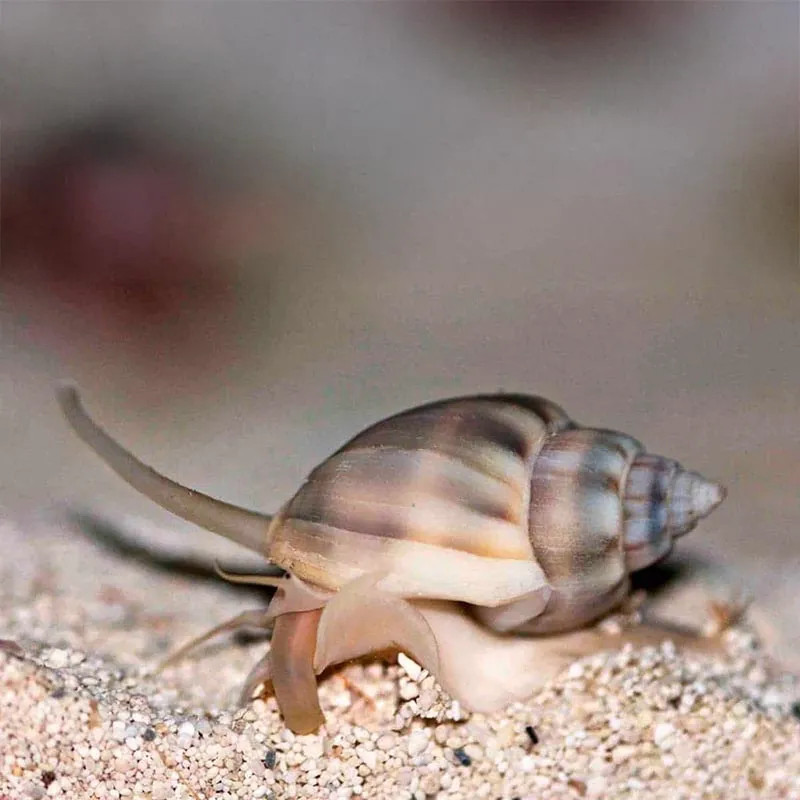Stocks Available
BANDED TROCHUS
SKU:216179
TROCHUS SP
N/A

Stock Available
Introduction Common Names: Nassarius Snail, Mexican Nassarius Snail, Pyramid Snail Scientific Name: Nassarius spp. Natural Habitat: Native to the sandy and muddy substrate of the Gulf of Mexico and other coastal regions of Mexico. These snails are commonly found in deeper waters, often in intertidal zones where they scavenge for food. Physical Characteristics Appearance: Nassarius Snails have a long, slender, and somewhat conical shell that is typically light brown to off-white, with dark markings or bands. Their shells are often slightly tapered at the tip, giving them a distinctive appearance. Size: Typically grows to about 1-2 inches (2.5-5 cm) in length. Lifespan: Average lifespan of 2-3 years in an aquarium under proper conditions. Habitat Requirements Tank Size: Suitable for tanks as small as 10 gallons; larger tanks are better for supporting multiple snails. Water Conditions: Temperature: 72-78°F (22-26°C). pH: 8.1-8.4. Salinity: 1.023-1.025 specific gravity. Aquascaping: A sandy or fine-gravel substrate is essential, as these snails burrow into the sand to scavenge. Live rock or rubble is also beneficial for them to hide and search for food. Diet Primary Diet: Carnivorous scavengers; feeds on detritus, leftover fish food, and decaying organic matter. Supplemental Feeding: Will also consume uneaten food particles and small invertebrates. You may supplement their diet with meaty foods like shrimp pellets, fish flakes, or other high-quality protein-based foods. Feeding Frequency: They are opportunistic feeders and will feed as needed. No specific feeding schedule is required. Compatibility Temperament: Peaceful; they are scavengers and do not pose a threat to other tank inhabitants. Suitable Tank Mates: Compatible with most reef-safe fish, invertebrates, and corals. Ideal tank mates include clownfish, wrasses, gobies, and other peaceful species. Incompatibilities: Avoid housing with aggressive or predatory fish, such as puffers, triggers, or large crabs, which may target or harm them. Care Level Difficulty: Easy to Moderate; suitable for beginner aquarists who can maintain stable water parameters. Health Monitoring: Monitor for signs of inactivity or failure to emerge from the sand, which could indicate poor water quality or stress. Nassarius Snails may also become vulnerable to high copper levels in the water, so avoid copper-based medications. Tank Maintenance: Regular water changes are important, as is keeping the sand substrate clean and free of excess detritus. Breeding Breeding in Captivity: Rare in home aquariums, but Nassarius Snails can breed in the right conditions. They lay egg masses on surfaces within the tank, which hatch into free-swimming larvae. Requirements: Larvae require planktonic foods to survive, which can be difficult to provide in most aquariums. Economic Considerations Market Demand: Highly valued for their role in scavenging and cleaning up detritus in reef and fish-only tanks. Pricing: Affordable and widely available in the aquarium trade. Conclusion The Nassarius Snail is an efficient and peaceful addition to marine aquariums, playing a vital role in keeping tanks clean by scavenging detritus and leftover food. Their low-maintenance nature and scavenging behavior make them an excellent choice for aquarists seeking a natural cleanup crew. As long as their substrate and water conditions are suitable, they will thrive and contribute to the health of the aquarium ecosystem.
Data sheet
5 other products in the same category:
Customers who bought this product also bought: